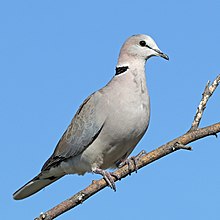jolj
ArboristSite Operative
This is what I found:
Jump to navigationJump to search
This article is about the species of dove found in eastern and southern Africa. For the bird often called ringneck dove in captivity, see Barbary dove. For other uses, see Ring dove (disambiguation).
The ring-necked dove (Streptopelia capicola), also known as the Cape turtle dove or half-collared dove, is a widespread and often abundant dove species in East and southern Africa. It is a mostly sedentary bird,[2][3] found in a variety of open habitats. Within range, its penetrating and rhythmic, three-syllabled crooning is a familiar sound at any time of the year.[3] Its name is derived from the semi-collar of black feathers on the lower nape,[4] a feature shared with a number of Streptopelia species. Like all doves, they depend on surface water. They congregate in large flocks at waterholes in dry regions[2] to drink and bat
Ring-necked dove
From Wikipedia, the free encyclopediaJump to navigationJump to search
This article is about the species of dove found in eastern and southern Africa. For the bird often called ringneck dove in captivity, see Barbary dove. For other uses, see Ring dove (disambiguation).
| Binomial name | |
|---|---|
Scientific classification

| |
| Conservation status | |
| Ring-necked dove | |

| |
| S. c. damarensis Etosha National Park, Namibia | |

Least Concern (IUCN 3.1)[1] | |
| Kingdom: | Animalia |
| Phylum: | Chordata |
| Class: | Aves |
| Order: | Columbiformes |
| Family: | Columbidae |
| Genus: | Streptopelia |
| Species: | S. capicola |
| Streptopelia capicola (Sundevall, 1857) |























































